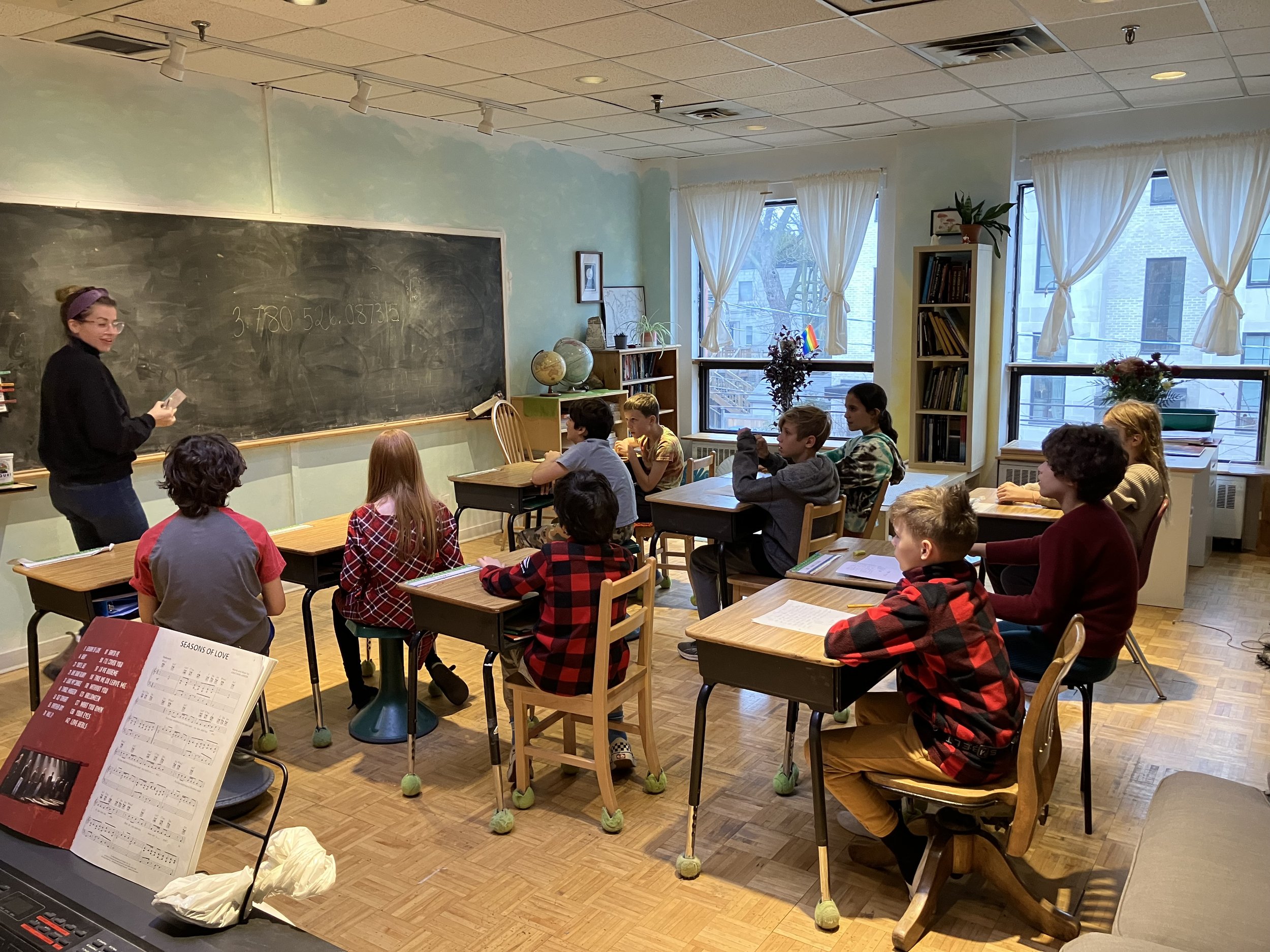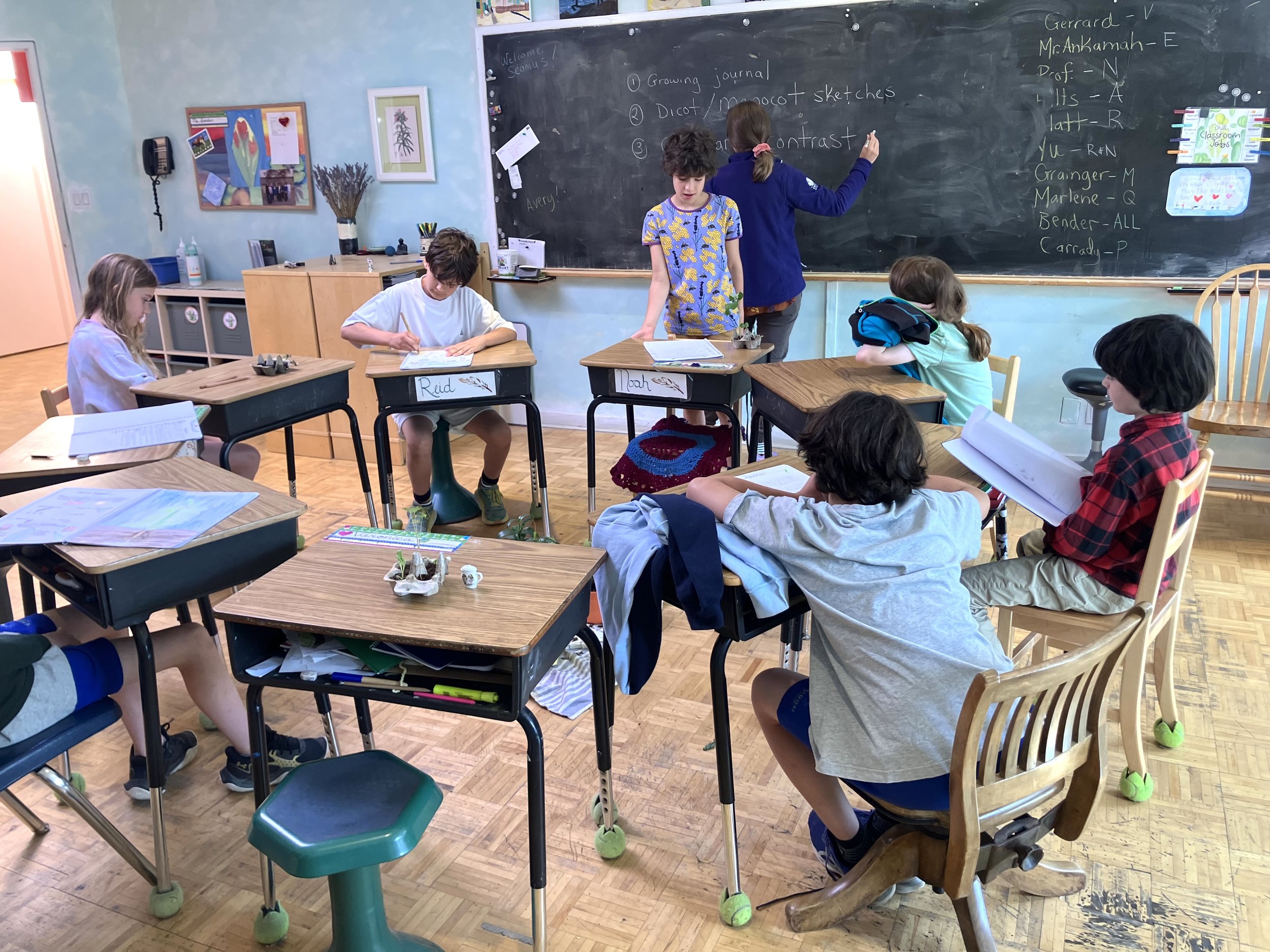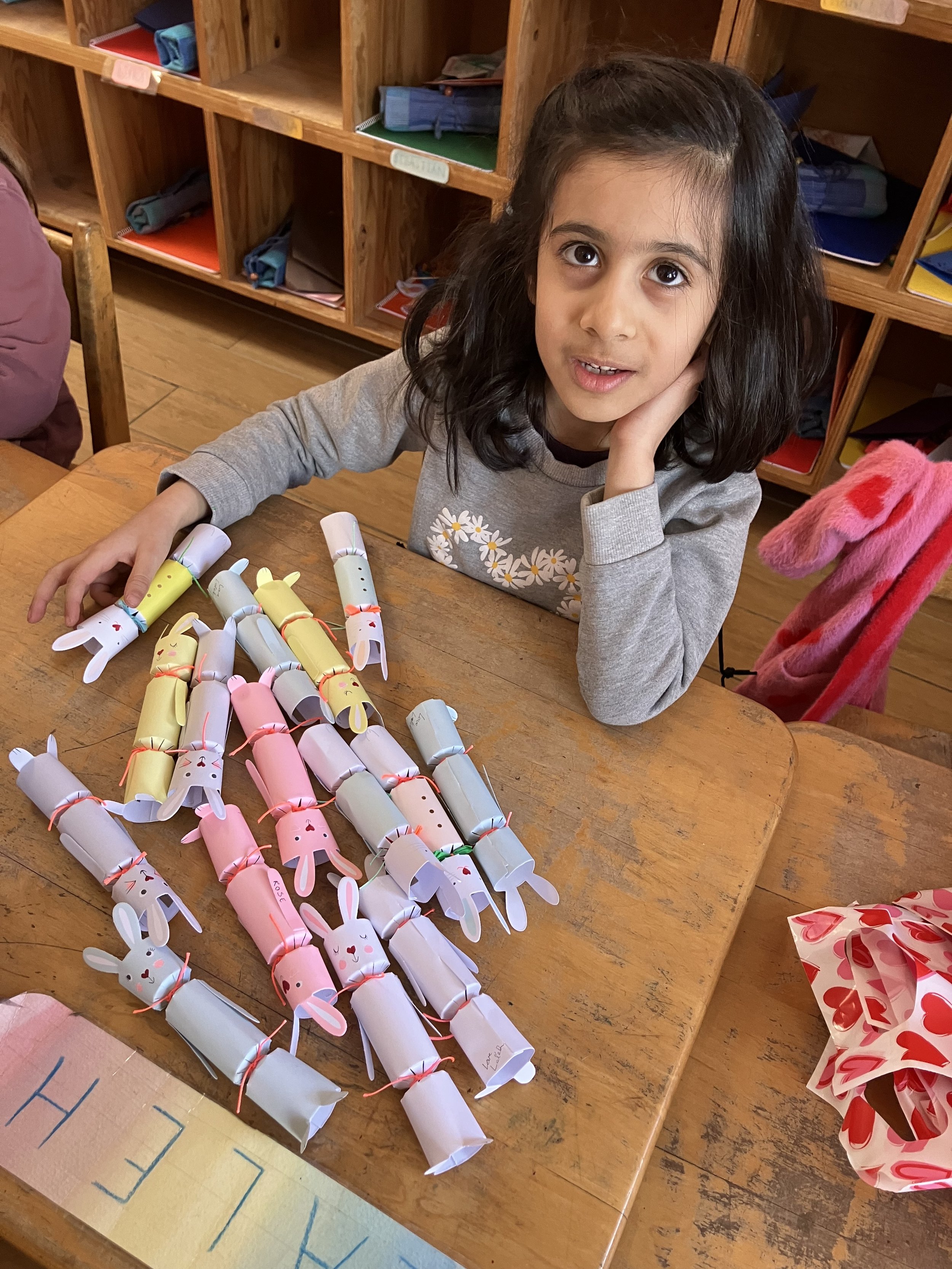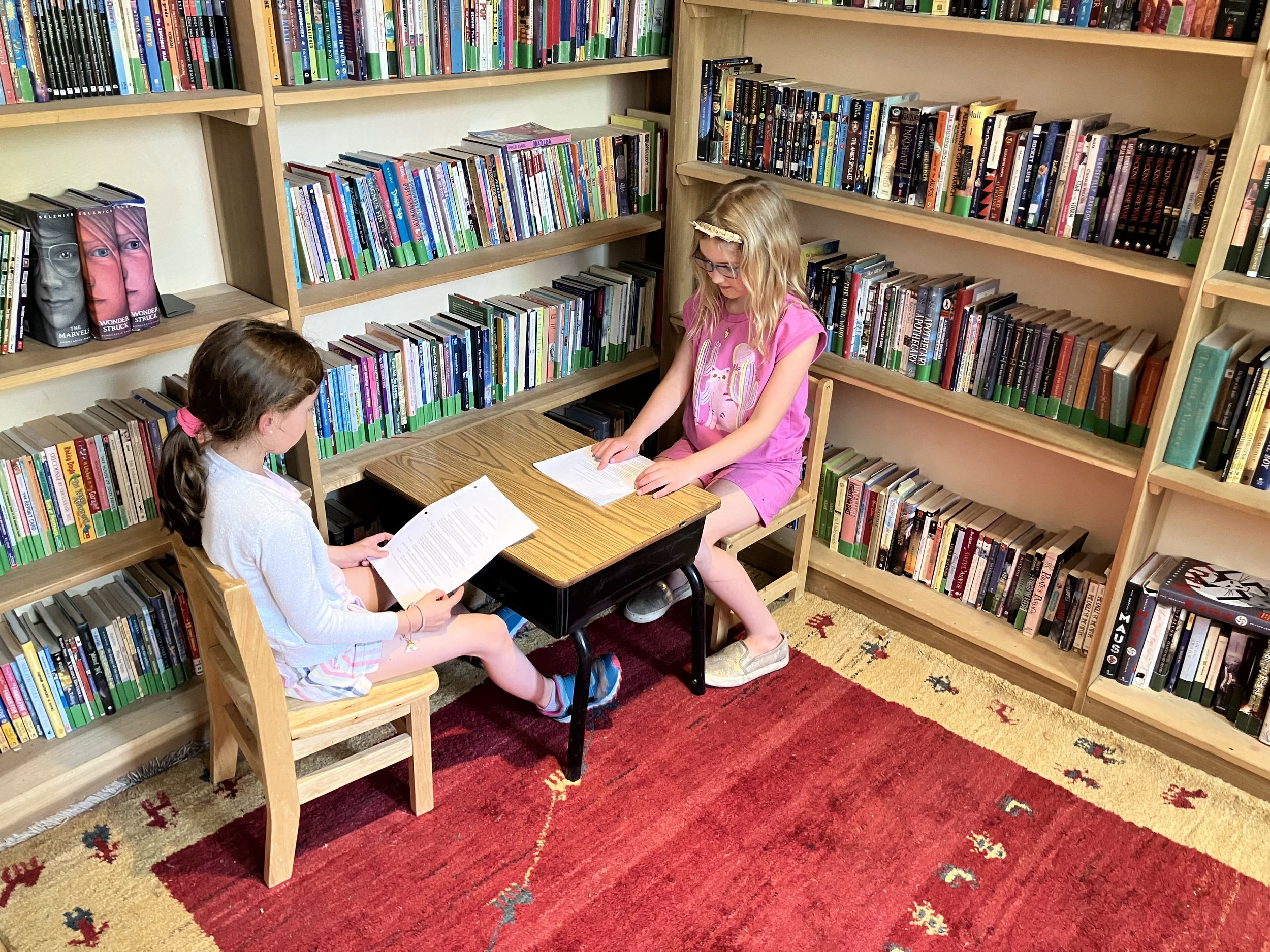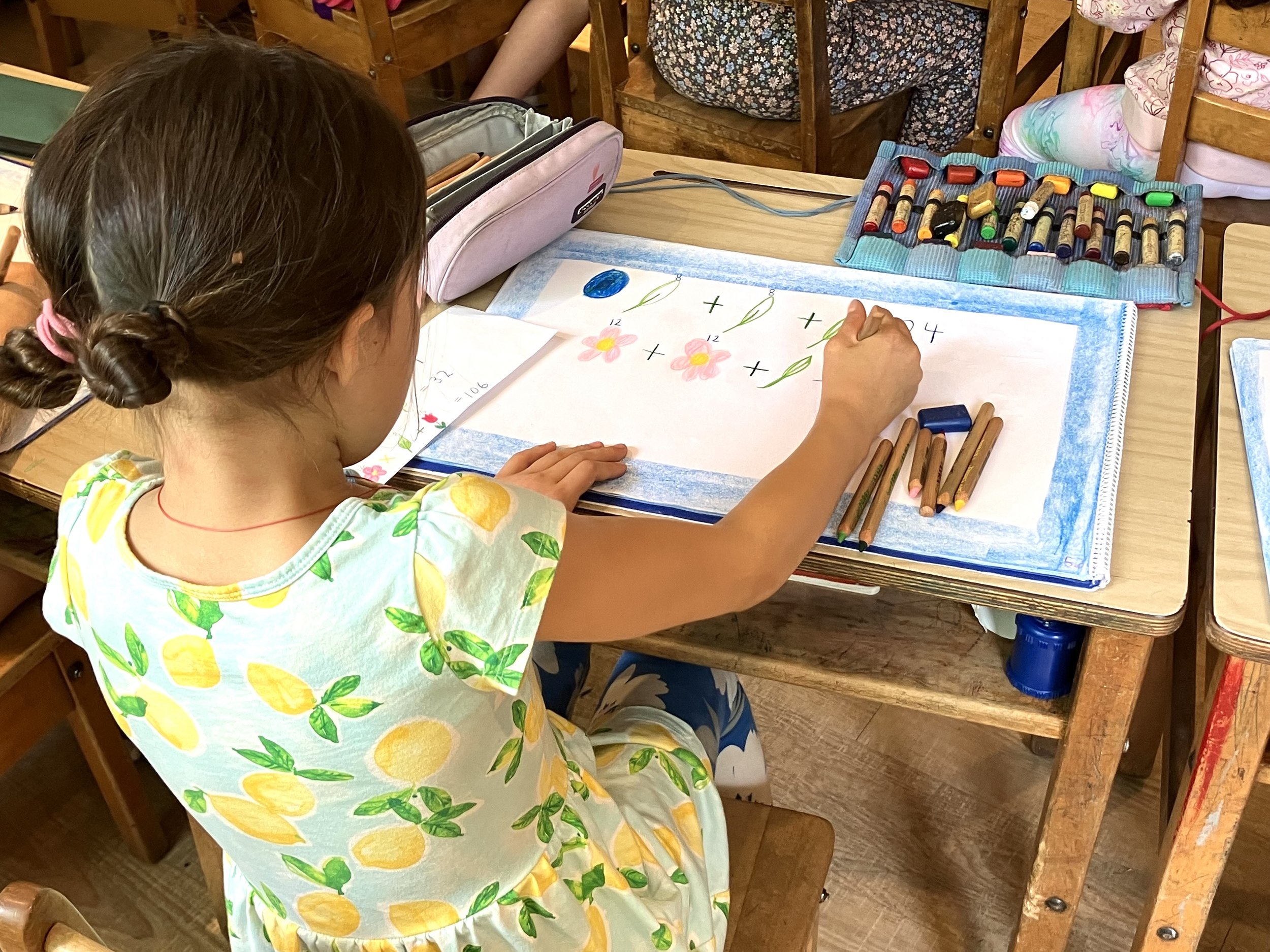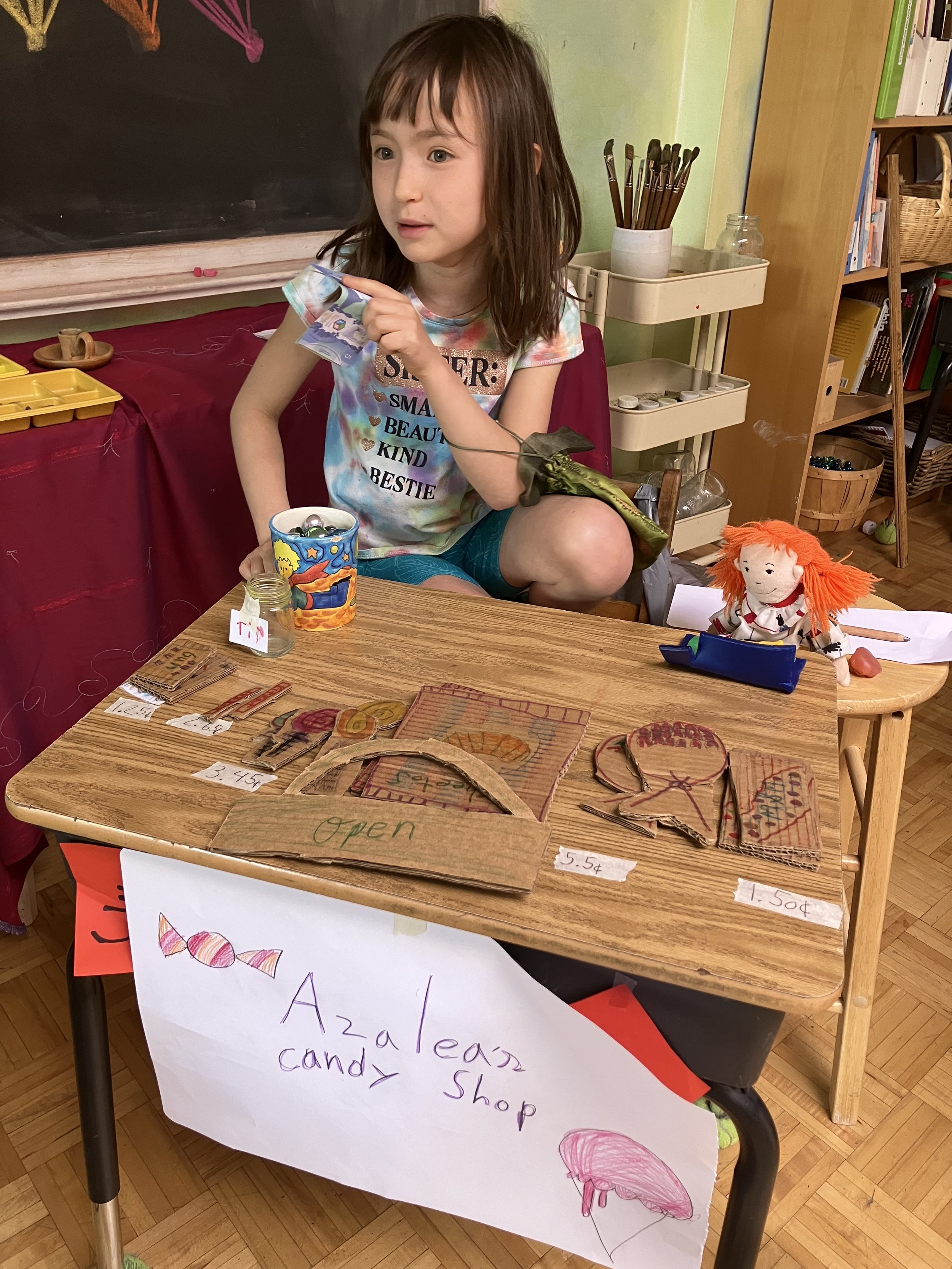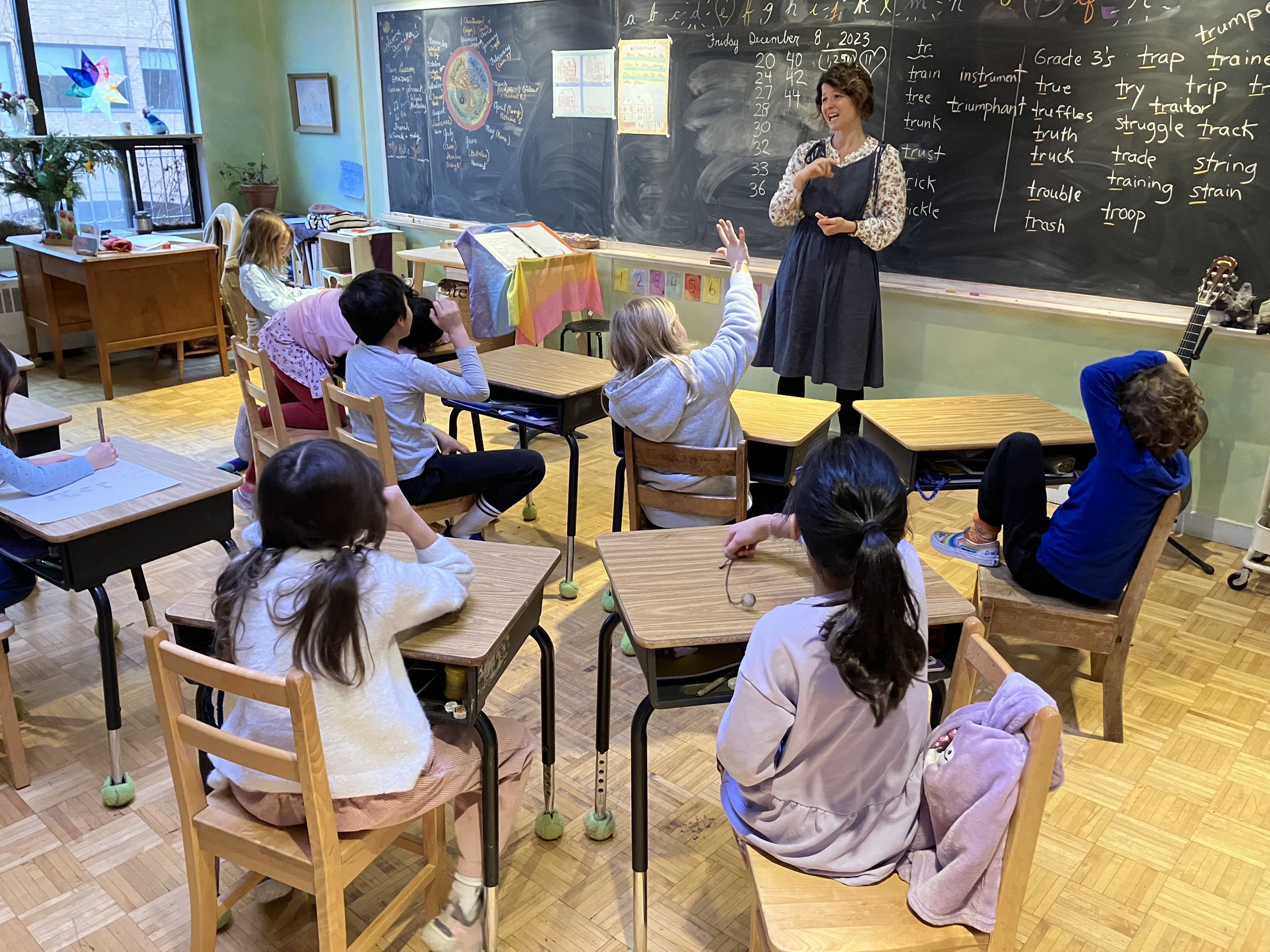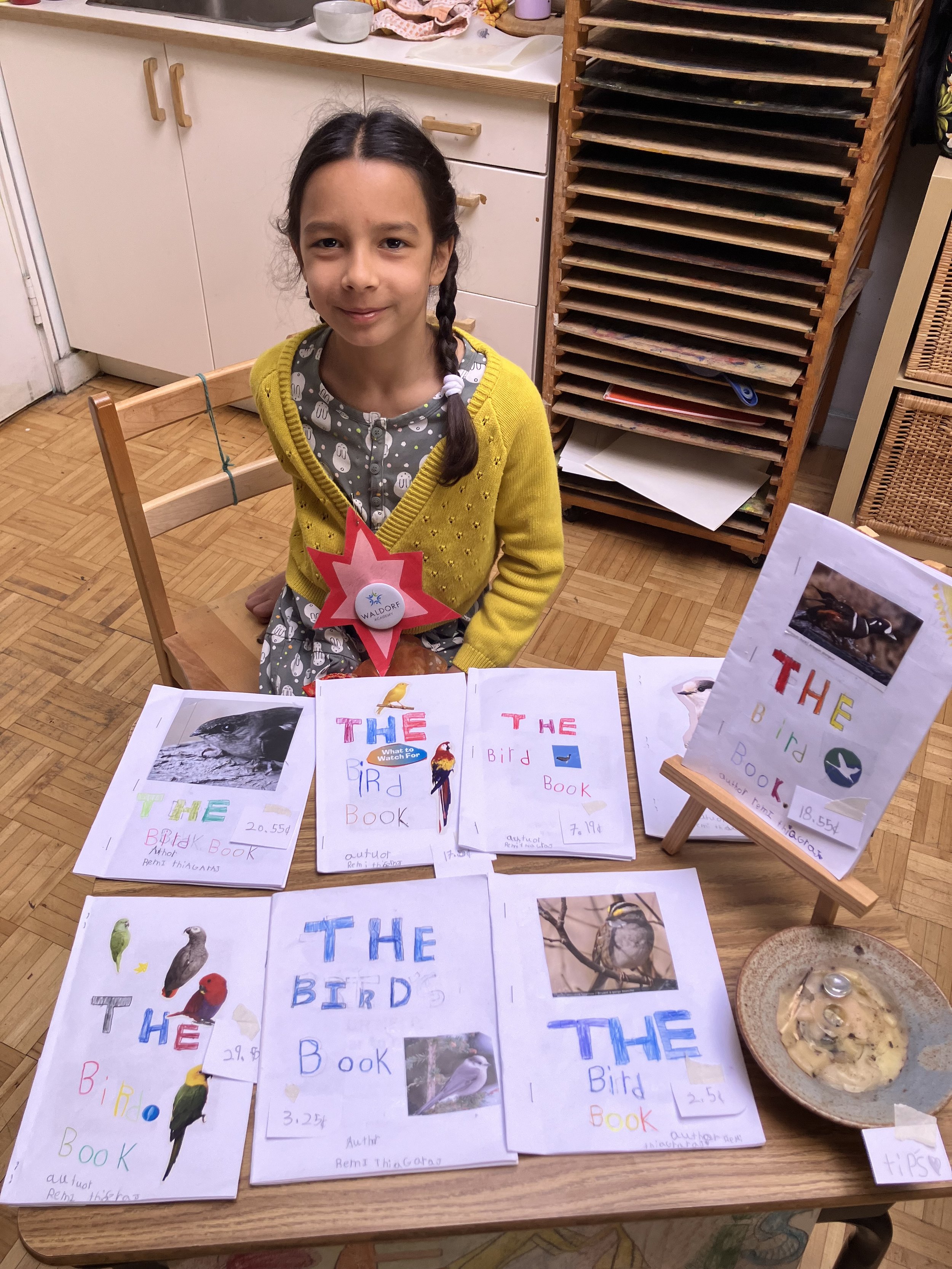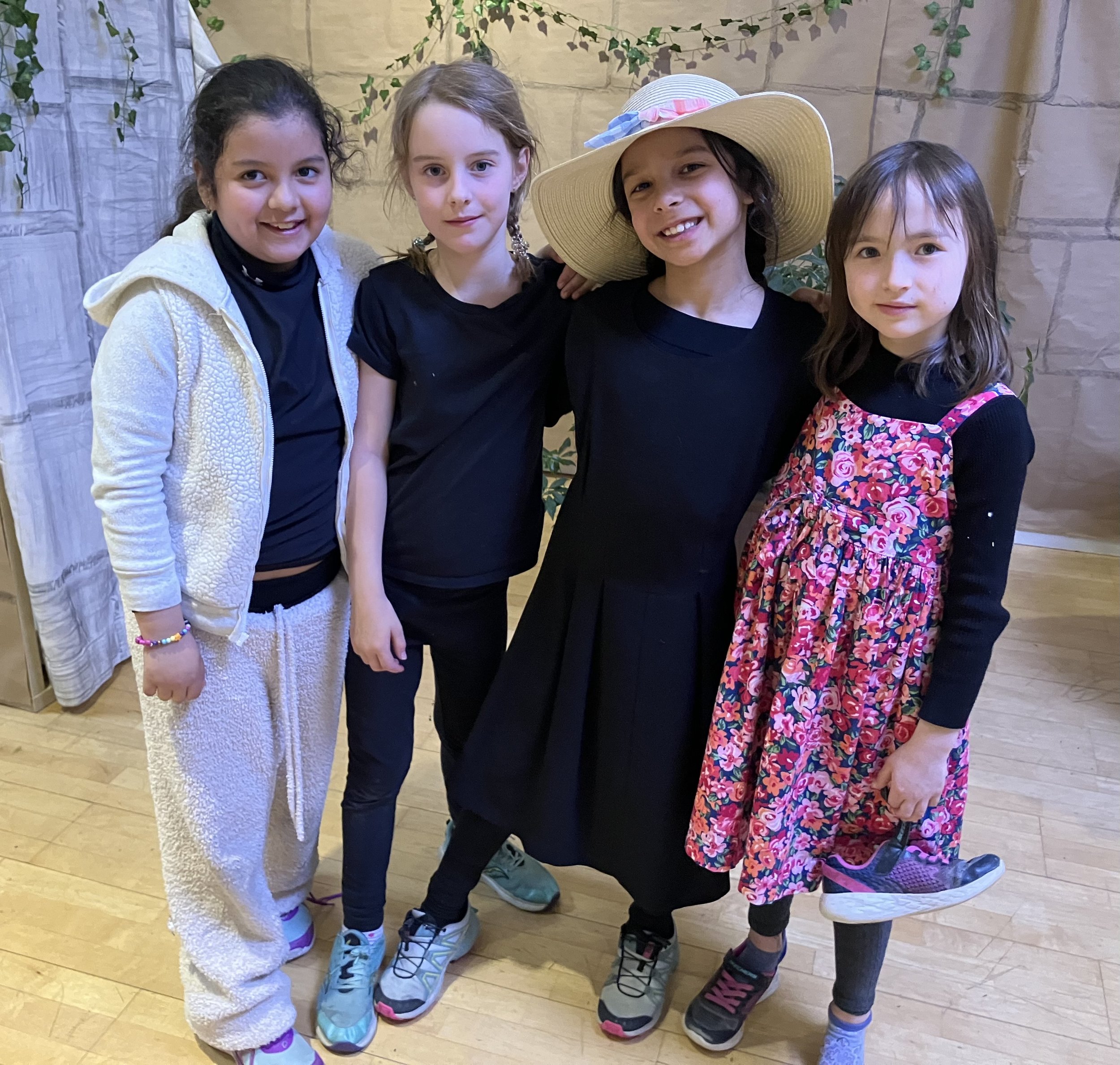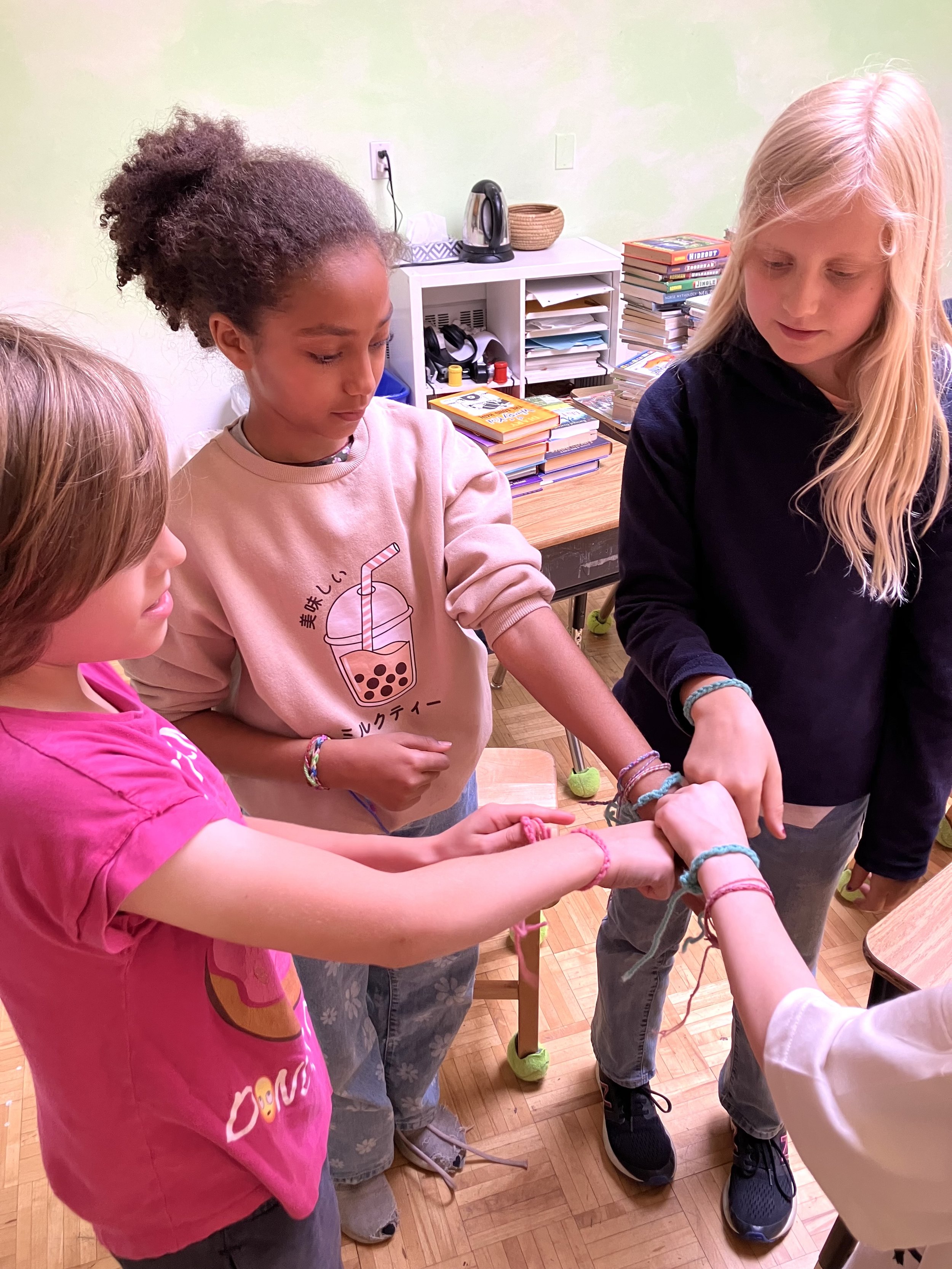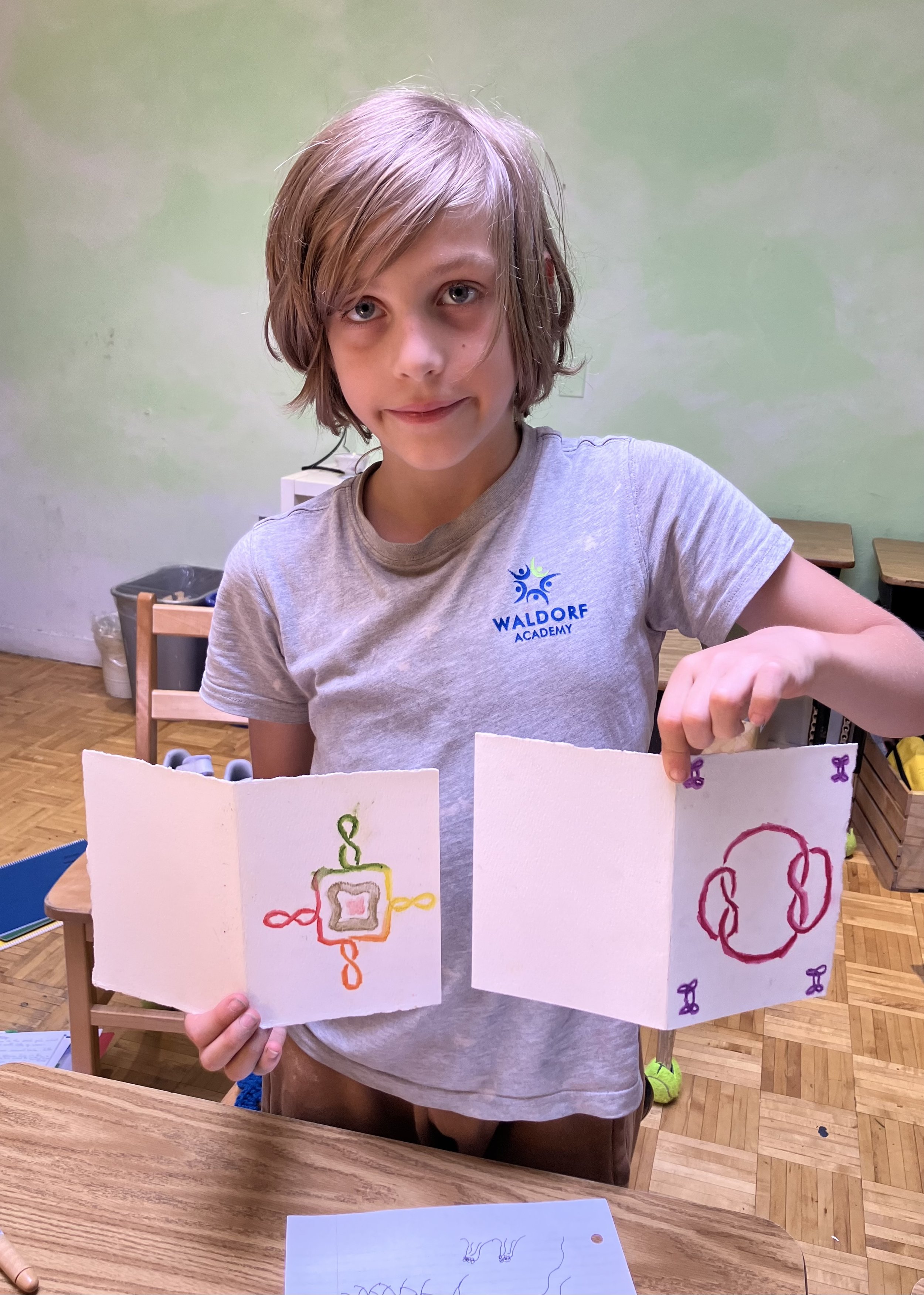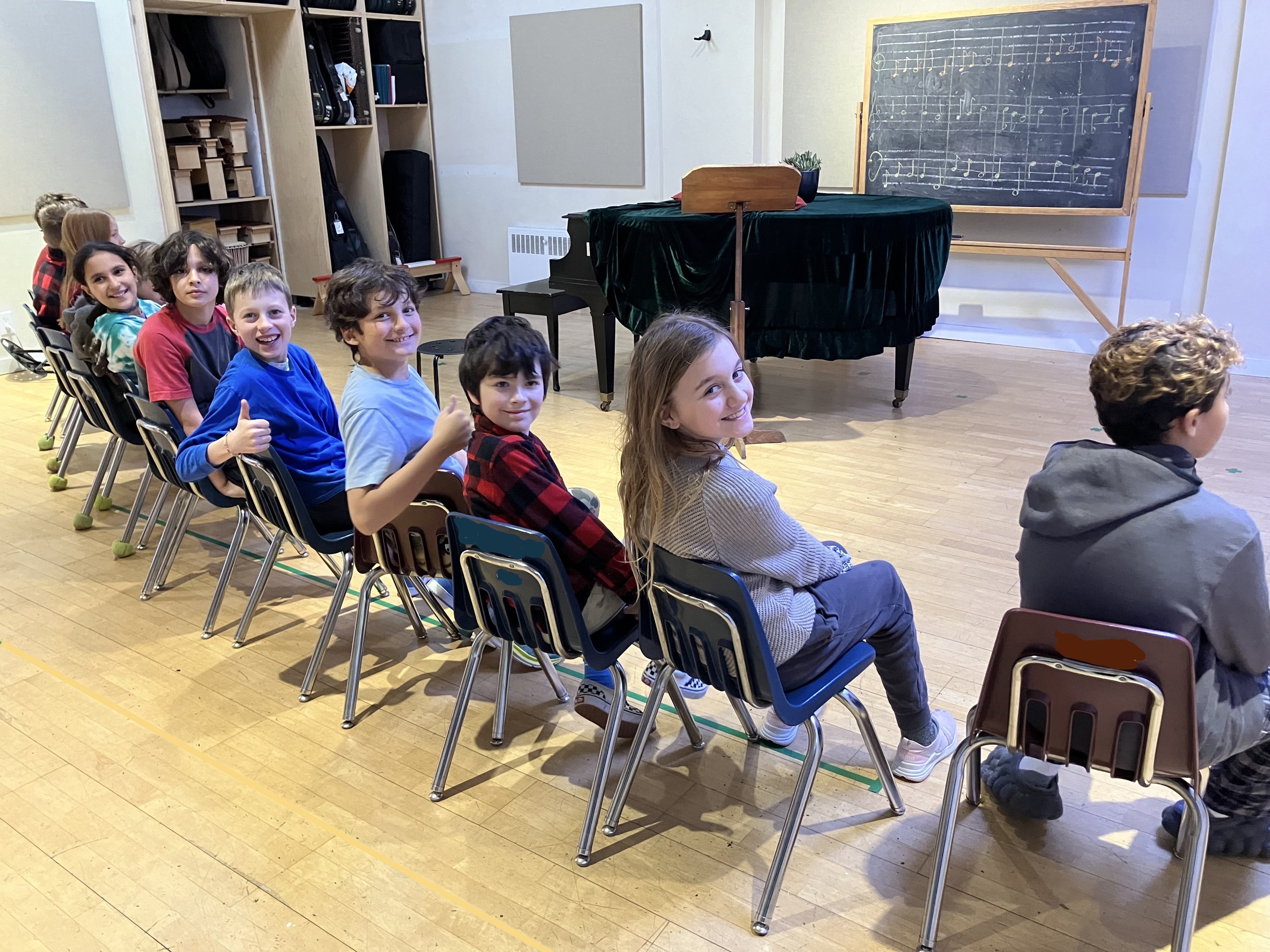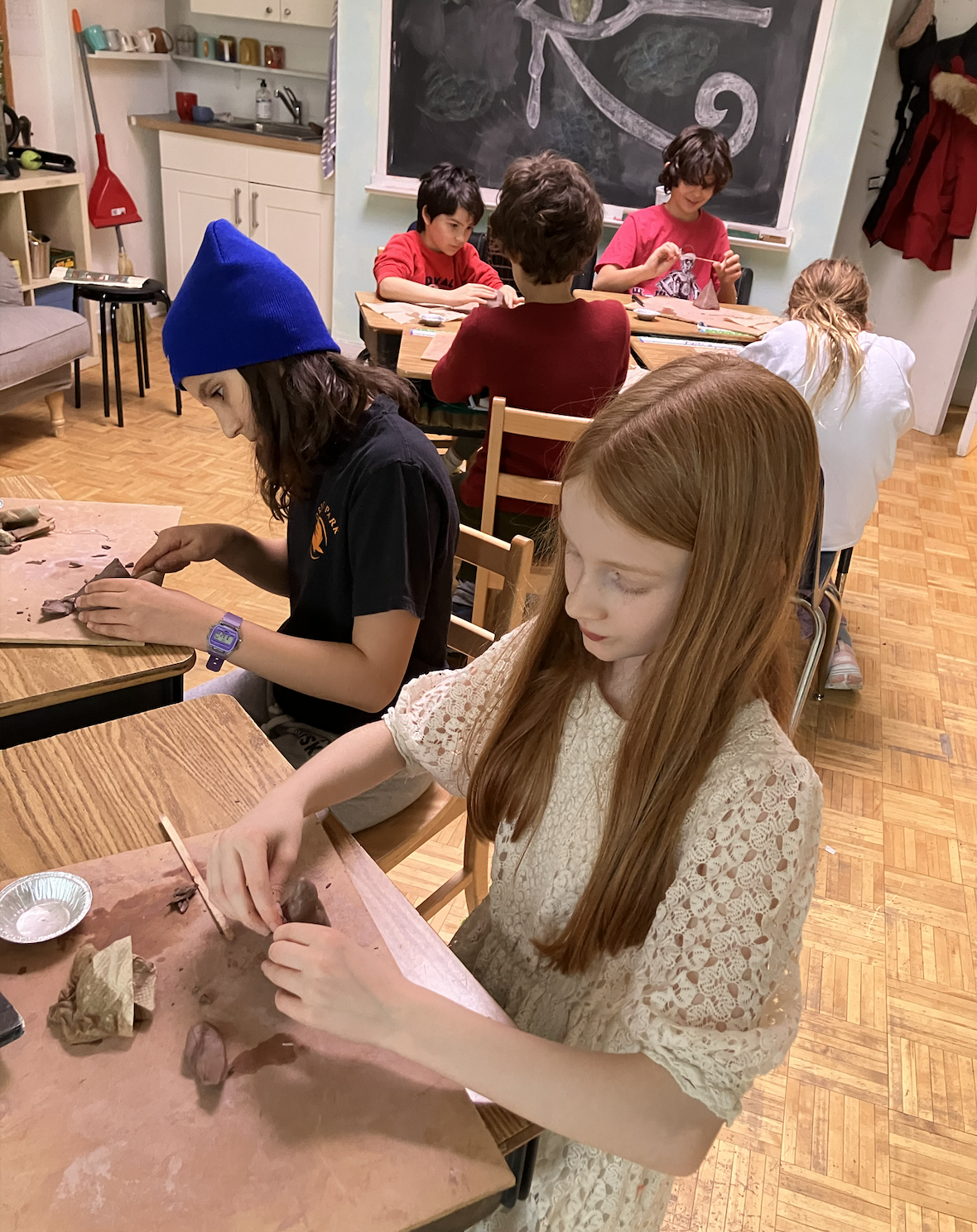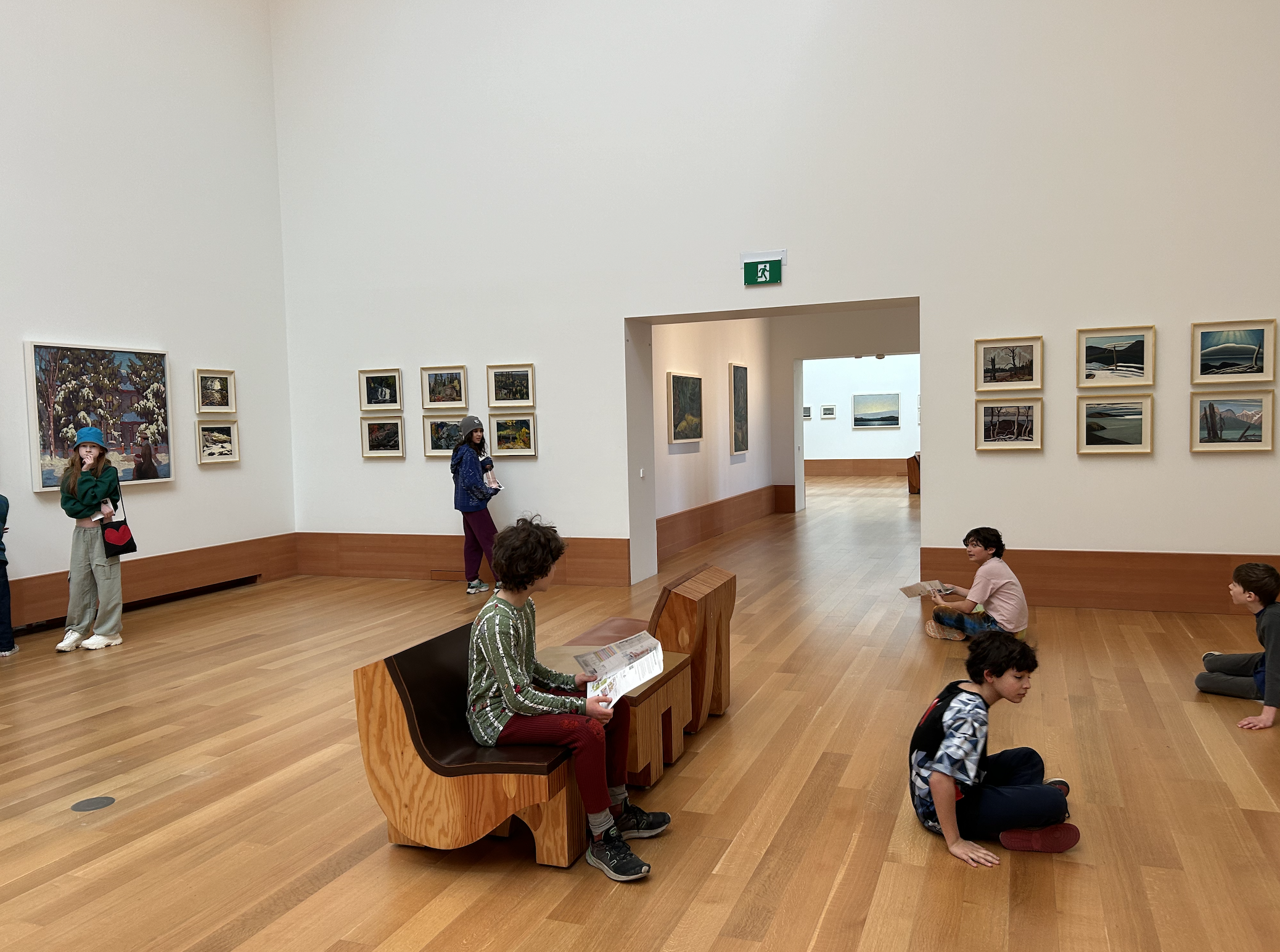Waldorf Elementary School (1-5)
GRADE 1
Grade 1 is an exciting time at our Waldorf Academy as children transition from the familiarity of our kindergarten into a more formal learning environment. Your first grader has a sense of wonder, imagination and physical readiness perfectly suited to this new challenge. Our curriculum is thoughtfully designed to nourish this curiosity, laying the foundation for a lifetime of learning.
-
Writing is taught by introducing the words through illustrations, stories and phonetics. Students learn the proper way to hold and use a variety of writing instruments. Children produce vibrant, full-page journals filled with letters, words, sentences, and illustrations.
-
Children work to remember and collectively recite several 20-30 minute poems and stories. They retain stories and texts by repeating and reflecting on their themes, situations and outcomes—the true beginning of reading comprehension. Stories form the foundation of Grade 1 studies, and allow students to acquire a true love of learning.
-
Literacy is built through listening, vocabulary development, poetry, and stories. Our teachers are trained in storytelling specifically for this age, and share folk and fairy tales from around the world as a foundation to spelling, reading, comprehension, memory-building, recall, etc.
-
All four basic math operations (addition, subtraction, multiplication, division) are introduced simultaneously through characterizations and stories that demonstrate their essential quality; i.e. Dexter Divide, who always shares. Number patterns, Roman numerals and place value are covered.
-
Stories that personify nature and relate its processes and qualities in experiential terms are most meaningful to the first grader. These provide a basis for scientific curiosity in the upper grades. Considerable time outdoors and weekly nature-walks reflect a natural sense of wonder and interest, supporting children’s innate comfort with natural phenomena. A variety of activities and field trips support early scientific learning.
-
Grade 1 students start formal education in French three periods a week—a practice that continues through Grade 8. In Grade 1, French is taught through recitation (both individually and collectively) of rhymes, short songs, and drawing corresponding images. French is read and spoken by the teacher throughout the period, allowing children to assimilate the sound and cadence of the language. Students respond to simple questions and engage in relevant movement and gestures to embody their learning.
-
Students practice beeswax modeling, freehand copying of specific patterns (‘form drawing’), watercolor painting, and traditional drawing using beeswax crayons. Everything is created from scratch: no lined paper, no tracing, no outlines. This methodology supports fine motor skills, spatial awareness, appreciation of the effects of colour, self-regulation skills in the form of patience, focus, coordination, and provides quiet and serene times during the busy school day. Artistic creations and freehand journaling become keepsakes of the year, and imprint memories in the psyche long-term.
-
From finger knitting to crochet, cross-stitch to leatherwork, handwork develops fine motor skills, creativity, and right-brain-left-brain coordination. Students also develop confidence that they can be adaptive self-sufficient, thereby gaining a sense of agency to carry through life. Grade 1 students learn to knit, and typically make pot-holders. As with other creative initiatives, handwork provides a quiet and peaceful time during an otherwise active day.
-
According to Waldorf founder Rudolf Steiner, humans are musical beings, and the making of music is essential in experiencing what it is to be fully human. Music is a staple of a Waldorf classroom. Song is part of almost every class, and teachers often sing through transitions, giving students auditory and emotional cues to move from one activity to another. Students sing prolifically as well, learning many songs by heart. The lyre is often introduced. .
-
Intentional movement is integrated into all Waldorf classrooms, regardless of subject. The purpose is to ready the body and mind to focus and concentrate, and to embody what is learned, deepening retention and recall. Games classes strengthen students’ sense of movement in space, their balance and awareness of others around them. Activities are chosen to ensure gross motor coordination and fine motor skills.
-
Students have multiple recesses and daily field trips to local parks to energize their bodies and activate their minds in social play, group dynamics, and exploration of the physical environment. They also go on a weekly nature walk to continue their natural comfort outdoors, to learn more about the environment, and to begin a lifelong sense of stewardship. Time outdoors and in nature is essential to the Waldorf ethos, and correlates with better mental health and academic success.
-
Field trips usually involve local nature centres, parks, orchards, or museums with a regional, natural, or environmental theme. Plays and festivals include: The Rose Ceremony where each Grade 8 student is connected with a Grade 1 buddy with whom they stay in close contact all year; the Michaelmas pageant to summon inner courage; the Lantern Walk to mark the need for light during the winter months; the Winter Fair to celebrate community; Mayfair to usher in Spring, the class play, and the closing Rose Ceremony, where the Grade 1 children give the Grade 8 students a beautiful send-off.
GRADE 2
At Waldorf Academy, the curriculum for Grade 2 is designed to align with the developmental stage of the child, focusing on nurturing imagination, creativity, and foundational academic skills. Overall, the Grade 2 Waldorf curriculum aims to foster a love for learning through imaginative and experiential activities, building a solid foundation in academic skills while nurturing emotional and social development.
-
In Grade 2, students undergo significant developmental changes as they encounter dissonant impulses within themselves, e.g., to be kind or mean, to be good or mischievous, to be truthful or secretive, etc. Fables that speak to our baser instincts, and tales of saints that reflect our virtues, provide children with indirect insight into the contrasting emotions they are beginning to encounter. They hear about a range of behaviors—trickery, folly, bravery, and selflessness—as essential aspects of life, showcasing the diversity of choices they can make as they evolve.
-
Reading continues with more complex stories and texts. The curriculum emphasizes phonics and whole language approaches, encouraging students to read while at the same time engaging in listening and telling stories, which provides the foundation for their love for reading.
-
Students practice writing through dictation, copying, and creative writing activities. They begin to write their own stories and develop their handwriting skills. Emphasis on listening to and retelling stories helps develop comprehension and verbal expression. Folktales are commonly used as source documents.
-
Building on the operations learned in Grade 1, students continue more complex problems and the introduction of simple multiplication and division. Math is often taught through stories, games, songs and hands-on activities.
-
The nature studies curriculum includes observation and study of the natural world. This involves exploring plants, animals, and seasonal changes. Experiential learning through outdoor activities and nature walks is common Hands-on activities such as planting seeds, observing insects, and understanding weather patterns help foster a connection with nature.
-
Second graders are immersed in French through songs, stories, short role plays, choral speaking and games. The majority of the students start responding individually and acting short sketches in French. Students may build and present a little play, e.g., « L’ours des couleurs » and the dance “Sur le pont d’Avignon”.
-
Students engage in drawing and painting, often inspired by the stories and subjects they are studying. This includes watercolours, wax crayon drawings, and other forms of visual art.
-
From finger knitting to crochet, cross-stitch to leatherwork, handwork develops fine motor skills, creativity, and right-brain-left-brain coordination. Students also develop confidence that they can be adaptive self-sufficient, thereby gaining a sense of agency to carry through life. Grade 2 students learn to crochet . As with other creative initiatives, handwork provides a quiet and peaceful time during an otherwise active day.
-
Music is integral to the Waldorf curriculum. Song is part of almost every class, and teachers often sing through transitions, giving students auditory and emotional cues to move from one activity to another. Students sing prolifically as well, learning many songs by heart. In Grade 2, singing, simple instruments (continuing the recorder), and rhythmic activities are a fundamental part of the curriculum. Children learn folk songs and basic music concepts, and participate in circle activities.
-
Students participate in two 45 minute periods of movement a week with the physical education teacher. Activities and games are chosen that strengthen the students' sense of movement in space, their sense of balance and their sense of others around them. Consideration is given to activities that engage their gross motor muscles in a coordinated way, and balancing games that improve fine motor movements. Each class consists of bean bag or ball work, a running/tag game, then a group/circle game, and skipping.
-
Students have multiple recesses and daily field trips to local parks to energize their bodies and activate their minds in social play, group dynamics, and exploration of the physical environment. They also go on a weekly nature walk to continue their natural comfort outdoors, to learn more about the environment, and to begin a lifelong sense of stewardship. Time outdoors and in nature is essential to the Waldorf ethos, and correlates with better mental health and academic success.
-
Field trips usually involve local nature centres, parks, orchards, or museums with a regional, natural, or environmental theme. Plays and festivals include: The two annual Rose Ceremonies; the Michaelmas pageant to summon inner courage; the Lantern Walk to mark the need for light during the winter months; the Winter Fair to celebrate community; Mayfair to usher in Spring, the class play, visit the apple orchard and sugar bush.
GRADE 3
Grade 3 supports the child’s growing ability to understand more abstract concepts while still engaging their imagination and creativity. This period, typically around ages 8-9, is marked by a greater awareness of the world and a growing sense of individuality. The curriculum provides a balance of academic learning, practical skills, and artistic expression, helping children make sense of the world around them as they grow. The curriculum is crafted to support this transition with practical, experiential, and imaginative activities.
-
The Grade 3 curriculum includes the exploration of several ancient cultures and civilizations. Stories and studies may include the lives and practices of early peoples, such as the Hebrews, Babylonians, or Egyptians. Students gain an understanding of community dynamics, trades, and historical developments. This can include learning about local history and traditions.
-
Students continue to develop their reading skills through both individual and group reading. They read more complex texts and stories, often including historical or cultural tales.
-
Writing skills are further developed through creative writing, dictation, and composing simple paragraphs. Students may write their own stories or reports related to their studies. Grade 3 includes anIntroduction to basic grammar concepts, such as parts of speech, sentence structure, and punctuation.
-
Grade 3 focuses on more advanced arithmetic, including multiplication and division. Students work with larger numbers, learn about long division, and begin to understand fractions and decimals. Application of math concepts in practical contexts, such as measurement in cooking or construction projects, helps to connect math to real-life experiences.
-
Study of agriculture and the relationship between humans and the natural world is a key element in Grade 3 at Waldorf Academy. Topics may include gardening, animal husbandry, and seasonal cycles. The curriculum includes hands-on experiments and activities related to basic principles of physics and chemistry, such as simple machines, magnetism, and basic chemical reactions. In Grade 3, students also engage in farming and gardening studies through storytelling, observation, and hands-on activities like composting and maintaining the school garden. The curriculum includes planting a garden focused on nourishing plants such as sunflowers, runner beans, pumpkins, and herbs. Students learn how farmers and gardeners collaborate, and go on a special trip to a farm to experience the daily life where they feed animals, assist in cheese-making, and participate in various farming tasks.
-
Grade 3 students work on stories, songs, games, sketches, and picture dictations. Much of the material is learned by heart and learning is very much a group activity. Individual children will gradually start speaking on their own, reflecting their comfort level with the new language. In the early grades the emphasis is on having the children experience the sounds, gestures and mood of the foreign language.
-
Students engage in more detailed and representational artwork. This may include drawing from nature, painting landscapes, and working on perspective. Practical crafts that integrate math and science concepts, such as woodworking, sewing, or building simple structures.
-
Music is integral to the Waldorf curriculum. Song is part of almost every class, and students and teachers often sing through transitions as they move from one activity to another. Grade 3 students add ukulele to their recorder work, and may explore musical notation and rhythm.
-
From finger knitting to crochet, cross-stitch to leatherwork, handwork develops fine motor skills, creativity, and right-brain-left-brain coordination. Students also develop confidence that they can be adaptive self-sufficient, thereby gaining a sense of agency to carry through life. Grade 3 students learn to knit a soft wool hat (many graduates have theirs to this day!). As with other creative initiatives, handwork provides a quiet and peaceful time during an otherwise active day.
-
Grade 3 offers opportunities for students to dramatize stories and participate in plays, enhancing their understanding of literature and building public speaking skills. Stories from different cultures help students connect with historical and cultural themes, and foster understanding of diversity.
-
Physical activities such as games, movement exercises, and dance support coordination and physical development. Activities and games are chosen that strengthen the students’ sense of movement in space, their sense of balance and their sense of others around them. Consideration is given to activities that engage their gross motor muscles in a coordinated way, and balancing games that improve fine motor movements. Each class consists of bean bag or ball work, a running/tag game, then a group/circle game, and skipping.
-
Students have multiple recesses and daily field trips to local parks to energize their bodies and activate their minds in social play, group dynamics, and exploration of the physical environment. They also go on a weekly nature walk to continue their natural comfort outdoors, to learn more about the environment, and to begin a lifelong sense of stewardship. Time outdoors and in nature is essential to the Waldorf ethos, and correlates with better mental health and academic success.
-
Field trips usually involve local nature centres, parks, orchards, or museums with a regional, natural, or environmental theme. Plays and festivals include: two annual Rose Ceremonies; the Michaelmas pageant to summon inner courage; the Lantern Walk to mark the need for light during the winter months; the Winter Fair to celebrate community; Mayfair to usher in Spring, the class play, and a 3-day, 2-night trip to a biodynamic farm.
GRADE 4
At Waldorf Academy, the Grade 4 curriculum is designed to match the developmental stage of the child at 9-10 years old. At this stage, children are capable of handling more complex concepts and are developing a greater sense of individuality and critical thinking. The Grade 4 curriculum focuses on expanding academic skills, enhancing practical abilities, and deepening understanding through experiential learning.
-
Fourth graders transition into a new phase of childhood where they gain a sense of comfort in themselves and their surroundings after undergoing considerable physiological change in Grade 3. They are prepared to embrace challenges, make more thoughtful decisions, and tackle increased academic demands. Their developmental stage aligns with the narratives found in Norse mythology and the Finnish Kalevala, which they engage with to refine their writing and composition skills.
-
Students read more complex texts, including classical literature, myths, and legends from various cultures. This helps deepen comprehension and introduces different writing styles.
-
Emphasis is placed on developing writing skills through narrative and descriptive writing, as well as creative writing projects. Students write reports or summaries of their reading. More advanced grammar concepts are introduced such as sentence structure and punctuation. Spelling and vocabulary development are key components. Many teachers introduce formal weekly spelling tests, while recitation continues and students delve deeper into complex language through drama and poetry.
-
Grade 4 students continue work with multiplication and division, including long division and multi-digit calculations, and are introduced to more complex topics such as factors, multiples, and basic geometry. Study of fractions is central, including how to add, subtract, multiply, and divide them. Practical applications of these concepts are explored through hands-on activities such as measuring lengths, volumes, and weights.
-
In Grade 4, students begin a more formal study of science, looking at connections between the human and the animal kingdoms. The students undertake their first in-depth, individual project in the block entitled Human and Animal. While natural science has been taught through story since Grade 1, Grade 4 marks a shift to a more structured science curriculum. The natural science block focuses on comparative zoology, highlighting the unique adaptability of humans compared to animals, which are tailored to specific habitats. As students explore a range of animals visually, they are encouraged to contemplate the fascinating diversity of the animal kingdom and reflect on their own nature in relation to it.
-
Grade 4 marks the beginning of a focused study of geography, as students naturally become more keenly aware of where they are in relation to their home, city, country, and globe. We begin with the physical geography of the local surroundings – rivers, ravines, hills, and lakes – and from this, gain an understanding of the economic foundations of the areas such as how rivers are used for transport and the building of canals and railroads. We also study the indigenous culture in the area and how they used the land. Finally, we build on these concepts to understand the links between human beings and their natural environment. Map-making begins as the children draw diagrams of their bedroom, classroom and their route from home to school.
-
In Grade 4, students are introduced to reading and writing in French. The students practice oral skills in French through sketches, vocabulary games, and short presentations. They may practice discussing topics such as how much something costs, going shopping, vacations sports, and dialogues such as asking for permission, accepting, refusing, introducing oneself, and expressing likes/dislikes). Students may construct a collective book about, for instance, “L’ours qui rêve”.
-
Students have an art class once per week with their class teacher doing wet-on-wet painting reflecting the subject matter of the central lesson. They are introduced to shading and continue with illustration and creative documentation in their educational journals.
-
From finger knitting to crochet, cross-stitch to leatherwork, handwork develops fine motor skills, creativity, and right-brain-left-brain coordination. Students also develop confidence that they can be adaptive self-sufficient, thereby gaining a sense of agency to carry through life. Grade 4 students specifically focus on cross stitch to develop precision, concentration and dexterity, create patterns and intricate woven forms, and recognize symmetry and balance. As with other creative initiatives, handwork provides a quiet and peaceful time during an otherwise active day.
-
Music is integral to the Waldorf curriculum. Song is part of almost every class, and teachers and students often sing through transitions from one activity to another. In Grade 4, students usually learn to read music, and add further instruments to their repertoire (e.g., xylophone and ukulele), to their ongoing recorder work. Students often participate in Junior Choir along with students in Grade 5.
-
Opportunities abound for Grade 4 students to participate in plays and dramatizations, enhancing their ability to interpret and express stories. This helps with public speaking and creative expression. Stories from various cultures are used to teach moral lessons, historical perspectives, and cultural values.
-
Activities and games are chosen that strengthen the students' sense of movement in space, balance and awareness of others around them. Consideration is given to activities that engage their gross motor muscles in a coordinated way, and balancing games that improve fine motor movements. Each class consists of bean bag or ball work, a running/tag game, a group/circle game, and skipping. Activities focus on developing coordination and physical skills, and emphasis is on learning to work as a team.
-
Students have multiple recesses and daily field trips to local parks to energize their bodies and activate their minds in social play, group dynamics, and exploration of the physical environment. They also go on a weekly nature walk to continue their natural comfort outdoors, to learn more about the environment, and to begin a lifelong sense of stewardship. Time outdoors and in nature is essential to the Waldorf ethos, and correlates with better mental health and academic success.
-
Field trips usually involve local nature centres, parks, museums and art galleries, specifically relating to the curriculum content. Plays and festivals include: two annual Rose Ceremonies; the Michaelmas pageant to summon inner courage; the Lantern Walk to mark the need for light during the winter months; the Winter Fair to celebrate community; Mayfair to usher in Spring, the class play, and a camping trip. Some teachers take their class to Saint Marie Among the Hurons to explore our local geography and history.
GRADE 5
The Grade 5 curriculum at Waldorf Academy is designed to engage students with a rich and varied academic experience that reflects their growing capacity for abstract thought and deeper understanding, and prepares them for the new challenges of Middle School. At this age, students are becoming more capable of abstract thinking and are developing a stronger sense of individuality and self. The Grade 5 curriculum aims to engage students with subjects that build their sense of responsibility and executive functioning in terms of homework and project completion, while maintaining a vibrant and energetic school atmosphere that continues to foster love of learning as school work becomes more demanding.
-
Grade 5 students focus on detailed study of ancient cultures such as Greece, Mesopotamia, Egypt, and India. Students learn about historical events, daily life, and contributions of these civilizations to modern society. Further exploration of world geography is also a staple of the curriculum, including physical features, climate zones, and cultural aspects of different regions. Map reading and creation are emphasized.
-
Students explore a range of literature, including historical texts, classical works, and epic tales. Genres might include myths, legends, and historical narratives that reflect different cultures and time periods.
-
Emphasis on creative writing, including essays, reports, and compositions. Students practice more complex writing structures and refine their grammar and spelling. Continued focus on advanced grammar concepts, sentence structure, writing styles, and expanding vocabulary. Writing exercises and activities reinforce these skills.
-
Grade 5 students study more advanced arithmetic, including long division with larger numbers, with an introduction to basic algebraic concepts such as equations and simple algebraic expressions. Math concepts are applied to real-world problems, such as budgeting, measurements, and data analysis.A unique aspect of the curriculum includes exploration of geometric shapes, their properties, and spatial relationships. Activities include drawing and constructing geometric figures and understanding concepts like symmetry and proportion.
-
Students work on fundamental concepts in physics such as forces, motion, energy, and simple chemical reactions. Hands-on experiments and observations are integral to the learning process. Study of plant and animal life, including detailed observation of plant structures, animal habitats, and life cycles. Students might engage in fieldwork and nature studies.
-
In Grade 5, students strengthen their awareness of grammatical patterns and participate in dialogues, sketches, and short plays. Simple questions to a reading text are practiced with the whole group, later individually, and eventually questions and answers are done in writing. Parallel to these topics, they are exposed to different grammar concepts like present tense verbs, article/adjective/noun agreement, singular-plural nouns, etc. Continued opportunities are offered to be immersed in the melody, cadence, and gesture of the language, and to experience its richness through poetry, song and story.
-
Advanced techniques are learned in drawing and painting, including, shading, and more detailed artwork. Projects often relate to historical and scientific studies from the curriculum.
-
Music is integral to the Waldorf curriculum. Song is woven into most classes, and teachers and students often sing through transitions from one activity to another. In Grade 5, students continue their study of musical theory, practice on increasingly more musical instruments (including alto recorder, strings, etc.), and may give ensemble performances. Students may also explore music history and different musical styles.
-
More advanced sewing projects and exploration of different textile techniques. Typical projects in Grade 5 include learning to knit across four and five needles as students follow a pattern and make their own socks.
-
Grade 5 students are formally introduced to woodwork, and create items such as a cheese knife or spinning top. Using only hand tools and without outlining in pencil, students form wood into well-proportioned and useful objects. Through this work they learn to use tools, to be self-sufficient, to find symmetry and balance, and develop keen observation and problem solving skills. The main project is specifically orchestrated to be long-term in order to require patience, perseverance, and dedication.
-
Students perform plays and engage in dramatization every year, which helps with public speaking, creativity, and interpretation of stories. The Grade 5 play typically reflects a key aspect of the curriculum to further deepen and imprint the foundational lessons of the year.
-
By Grade 5 students are able to appreciate the rules and regulations of conventional games such as basketball, volleyball and badminton, and have increasing tolerance for the element of competition. As the students become more independent, further emphasis is placed on skills development, technique, and self-discipline. The pinnacle of the Grade 5 movement classes is the Greek Olympiad in late May. Several regional Waldorf Schools come together for this two-day event, typically in Aurora, New York. The competition includes javelin, discus, running, long-jump and Greek wrestling, and awards are given for demonstration of competitive virtues as well as excellence in sport. Students perform in each event and strive to do their individual best. Initial training for this event begins early in the year with stretching, running and spatial dynamics-exercises to build strength, form, and grace. Formal event training begins in late March.
-
Field trips usually involve local nature centres, parks, museums and art galleries, specifically relating to the curriculum content. Plays and festivals include: two annual Rose Ceremonies; the Michaelmas pageant to summon inner courage; the Lantern Walk to mark the need for light during the winter months; the Winter Fair to celebrate community; Mayfair to usher in Spring, the class play. A highlight of Grade 5 is the class trip to another Waldorf school (typically Aurora, New York) to meet up with students from several other Waldorf schools for a mock Greek Olympiad.
-
Grade 3 specifically focuses on the theme of self-sufficiency and sustenance. Students learn how to build shelters, to cook, to sell goods, reflecting their dawning awareness that they will one day have to do all this themselves to sustain a modern life. To better understand where food comes from and how agriculture works, the class goes on an overnight trip to Glencolten Farm, where food is grown organically, using time-worn methods. Students learn to plant seeds, furrow the grounds, milk cows, and spend time near animals. Music, cart-rides and outdoor fires complete the experience.
-
As Grade 4 students become more aware of where they are in relation to geographical landmarks and cultural events, they often go on a trip to a place with Indigenous meaning such as St. Marie Among the Hurons, or Everlasting Tree School. The Grade 4 curriculum includes opportunities for many of our social renewal initiatives often including plays and activities that honour Indigenous stories. Please also see our Diversity, Equity and Inclusion.
-
One of the themes of the Grade 5 year is Greek history, along with Greek philosophy, architecture, and athletics. To fully immerse themselves in the material, and to embody the virtues of endurance, perseverance, gracefulness, and attention to detail, students train in a number of classic sports including javelin, discus, wrestling, long-jump, sprinting, and a distance run. In the spring, they travel to a sister school, typically Aurora Waldorf School, where they compete with several other schools in classic Greek fashion, winning medals not only for best physical achievement, but also for displays of courage, strength, compassion, perseverance, and kindness.
-
Most Waldorf festivals correspond with the changing seasons, keeping us in touch with the world around us and in tune with nature’s rhythms. In this vein, Michaelmas is commonly associated timewise with the beginning of autumn and harvest. It involves a pageant with villagers who are afraid of a dragon that is threatening their flocks and livelihood. St. George comes to their aid, and tames the dragon. Dragon bread and ginger candy are often served. But there is more to this celebration than pageantry. As is the case with many traditions, it celebrates something universal to all humanity: in this case, the courage needed to face external and internal challenges. Some scholars link Michaelmas to Yom Kippur, another autumn celebration that focuses on self-reflection and moral renewal. Similarly, at Michaelmas, we are invited to tame our inner and outer ‘dragons’, to find balance in the equinox before the contractions of winter, and to summon inner fortitude, and strength in community:
“Michael’s message to humanity is not to try to slay the dragon within ourselves, for we would not live in freedom if we did. Rather, our challenge is to transcend it with consciousness.”
— David Mitchell
-
Maypole celebrations are at least 2,000 years old, and were practiced in Roman Britain to thank goddess Flora for her gift of spring. In more modern terms, the tall maypole itself, around which we all gather, is considered a beacon of communal unity: “As dancers weave around its base, each holding a ribbon, they create intricate patterns, symbolizing the interplay of life, love, and the eternal cycle of seasons” Non-denominational reverence, ritual, and rhythm are all aspects of Waldorf education. In an age often dominated by technology and rapid change, the tradition of the Maypole serves as a reminder of our deep-rooted connection to the natural world and to each other.
-
A fair at the outset of winter is a tradition at many Waldorf schools. Waldorf Academy’s Winter Fair is open to the public, and offers magical and seasonal activities for young children including candle-dipping, craft-making, making a wish at the Wishing Tree, and visiting the Good Witch for a cookie. The magic of the event last long into our students’ adolescence, with alumni returning year after year to refresh their memories of the magic of childhood. Vendors sell food and wares, and the community gathers for music and dance in the decorated auditorium. The fair is organized and mounted by families in the school, and offers a beautiful opportunity for parents to meet and mingle, and to be part of the greater community to which we all belong.



